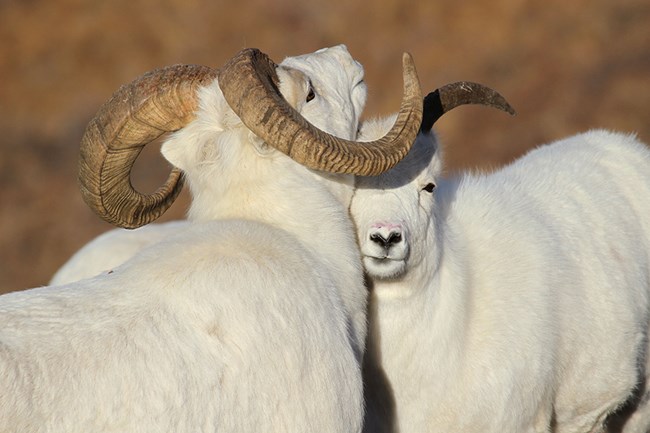Last updated: November 1, 2022
Article
Dall's Sheep Resource Brief for the Arctic Network
Dall's sheep inhabit some of Alaska’s most rugged alpine areas.

Jared Hughey
Status and trends of Dall’s sheep in the Arctic Network
There were an estimated 6,898 sheep (95% Credible Interval [CrI] 6,158-7,766 sheep) in 2015 in Gates of the Arctic National Park and Preserve (GAAR) and 740 sheep (95% CrI 620-899 sheep) in 2019 in the Western Arctic National Parklands (WEAR), which includes habitat in Noatak National Preserve (NOAT), Kobuk Valley National Park and Cape Krusenstern National Monument. These numbers indicated a 21% decline in GAAR since 2009, and a disturbing 74% decline in WEAR since 2011.
Annual surveys of subareas within GAAR and WEAR provide more detail about these declines. Populations were stable in the Itkillik subarea of GAAR from 2009 to 2012 (~1,600 sheep) but declined ~60% across 2013 and 2014. Populations have remained low but stable in the Itkillik subarea from 2015 to 2019 (~670 sheep). Sheep populations have been on a steep downward trend in the Western Baird subarea of WEAR, declining 73% from 2011 to 2019, when populations reached a remarkable low of 174 sheep (95% CrI 141-230).
The number of lambs per 100 ewe-like sheep (which includes ewes, yearlings, and young rams), is often used as an indicator of reproductive success for Dall’s sheep. The average ratio is ~30 lambs per 100 ewe-like sheep. Almost no lambs were observed in the Itkillik and W. Baird areas in 2013 and 2014. There was an average of 35 lambs per 100 ewe-like sheep in the Itkillik subarea (GAAR) and 33 lambs per ewe-like sheep in the W. Bairds (WEAR) from 2015-2019. Unfortunately, these higher than average reproductive rates have not translated into population growth. All hunts were closed by emergency order in WEAR in 2014 due to the population decline and have remained closed through 2020.


NPS/Matt Cameron
How does climate affect Dall’s sheep populations?
Environmental conditions strongly affect Dall’s sheep populations, especially in WEAR and GAAR, where sheep are living at the northern edge of their range. New research from NPS and other scientists, has revealed how climate can strongly affect sheep populations. In one study, lamb survival was closely linked to how early snow melted in the spring--lambs were more likely to perish when snow remained late into spring. In another study, adult sheep had higher survival rates when winter temperatures were mild, but only benefitted from warmer temperatures up to a point. When winter and spring temperatures fluctuate too high, freeze-thaw cycles and freezing rain can lock plants under a crust of ice and make foraging difficult. These new insights are consistent with the patterns we documented in the Arctic Parklands; sheep populations declined dramatically in 2013 and 2014, two years with cold snowy winters and late icy springs. How sheep populations will respond to ongoing climate change is not clear. We will continue to conduct surveys to assess further population changes.
Jared Hughey
Why Dall’s sheep are important
Dall’s sheep are an alpine adapted species at their northernmost extent in the Brooks Range of Alaska. GAAR and NOAT encompass most of the available habitat in the central and western Brooks Range and were estimated in the 1980’s to contain 13-15% of the world’s Dall’s sheep. Dall’s sheep are an important subsistence species for local residents and highly valued where sport hunting is permitted in preserves. Dall’s sheep are also one of the most visible large mammals for wildlife viewing in northern Alaska.Widespread and dramatic declines in sheep numbers were observed in the early 1990s and again in 2013-2015, resulting in emergency closures for subsistence and sport hunting in WEAR. Monitoring population trends is critical to conserving Dall’s sheep and maintaining hunting opportunities. Moreover, information about sheep abundance, distribution, demographics and health can be highly indicative of changing environmental conditions over time.
What we want to know about Dall’s sheep
- Long-term trends in sheep abundance and distribution.
- Long-term trends in sex and age composition of sheep populations.

NPS/Jared Hughey
How we monitor Dall’s sheep
The Dall’s sheep monitoring program in ARCN is based on aerial distance sampling conducted at two scales: 1) park-wide sampling across GAAR and WEAR; and 2) more frequent sampling in key harvest management areas: the Itkillik and Anaktuvuk subareas in GAAR and the western Baird Mountains in WEAR. Estimates of total abundance and counts for different sex and age classes are produced using Bayesian modeling. These efforts are in collaboration with the Central Alaska Network, which monitors Dall’s sheep populations in Denali National Park and Preserve, Wrangell-St. Elias National Park and Preserve, and Yukon-Charley Rivers National Preserve. The park-wide aerial surveys are conducted every four years and every one or two years in the sub areas.
NPS/Dylan Schertz
How monitoring Dall's sheep can help park managers
- Detect changes in regional and local abundance of Dall’s sheep
- Provide information about sheep demographics and health in areas where hunting is managed
- Improve our understanding of alpine environmental conditions and the effects of environmental change on local sheep populations

NPS/Dylan Schertz
For more information, contact:
William Deacy, ARCN Sheep BiologistWilliam_deacy@nps.gov
(907) 455-0684
